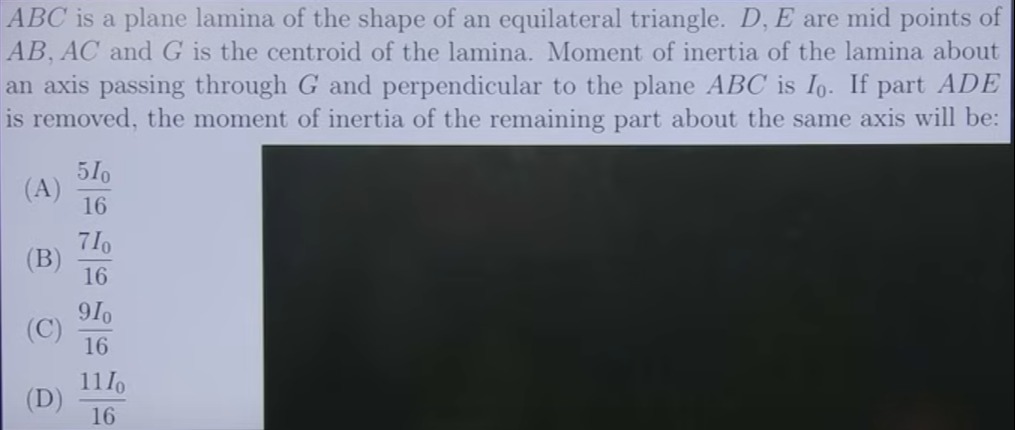Question
Question: ABC is a plane lamina of the shape of an equilateral triangle. $D, E$ are mid points of $AB, AC$ and...
ABC is a plane lamina of the shape of an equilateral triangle. D,E are mid points of AB,AC and G is the centroid of the lamina. Moment of inertia of the lamina about an axis passing through G and perpendicular to the plane ABC is I0. If part ADE is removed, the moment of inertia of the remaining part about the same axis will be:

165I0
167I0
169I0
1611I0
167I0
Solution
The problem asks us to find the moment of inertia of the remaining part of an equilateral triangular lamina after a smaller equilateral triangular part is removed. The axis of rotation passes through the centroid of the original lamina and is perpendicular to its plane.
Let the original equilateral triangle be ABC, with side length 'a' and mass 'M'. Its centroid is G. The moment of inertia of the full lamina about an axis through G and perpendicular to the plane is given as I0. The formula for the moment of inertia of an equilateral triangular lamina of mass 'm' and side 's' about an axis through its centroid and perpendicular to its plane is Ic=24ms2. So, for the full triangle ABC: I0=24Ma2. (Equation 1)
The part removed is triangle ADE, where D and E are midpoints of AB and AC respectively. Triangle ADE is also an equilateral triangle. The side length of ADE is s′=a/2. The area of ADE is (43)(a/2)2=41(43a2), which is 1/4 of the area of ABC. Since the lamina is uniform, the mass of ADE is M′=M/4.
First, calculate the moment of inertia of triangle ADE about its own centroid (GADE). IADE,c=24M′(s′)2=24(M/4)(a/2)2=24(M/4)(a2/4)=16×24Ma2=384Ma2.
Next, we need to find the moment of inertia of triangle ADE about the axis passing through G (the centroid of the full triangle ABC). We use the parallel axis theorem: I=Ic+Md2. We need to find the distance 'd' between G and GADE. Let's place vertex A at the top, say at (0,23a). The base BC is on the x-axis, from (−a/2,0) to (a/2,0). The centroid G of triangle ABC is at (0,31×23a)=(0,63a). For triangle ADE, the vertices are A(0,23a), D(−4a,43a), E(4a,43a). The centroid GADE of triangle ADE is at (0,31(23a+43a+43a))=(0,31(23a+23a))=(0,313a)=(0,33a). The distance 'd' between G and GADE is the difference in their y-coordinates: d=∣33a−63a∣=∣623a−3a∣=63a. So, d2=(63a)2=363a2=12a2.
Now, apply the parallel axis theorem for triangle ADE about the axis through G: IADE,G=IADE,c+M′d2 IADE,G=384Ma2+(4M)(12a2) IADE,G=384Ma2+48Ma2 To add these, find a common denominator, which is 384. (384=8×48). IADE,G=384Ma2+3848Ma2=3849Ma2.
From Equation 1, we know I0=24Ma2. This means Ma2=24I0. Substitute this into the expression for IADE,G: IADE,G=3849(24I0)=3849×24I0. Since 384/24=16, IADE,G=169I0.
The moment of inertia of the remaining part is the moment of inertia of the full triangle minus the moment of inertia of the removed part (about the same axis): Iremaining=I0−IADE,G Iremaining=I0−169I0 Iremaining=(1−169)I0=(1616−9)I0=167I0.
The final answer is 167I0.
